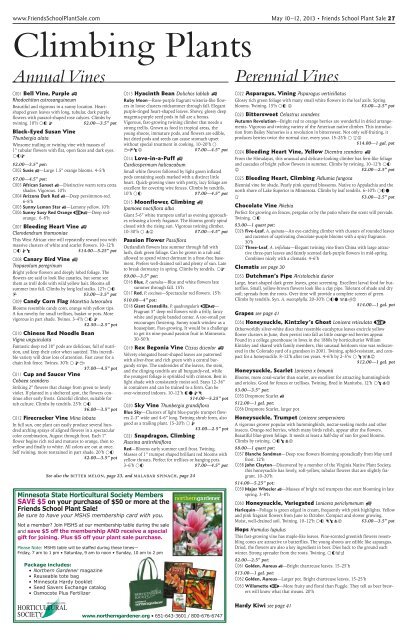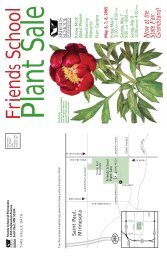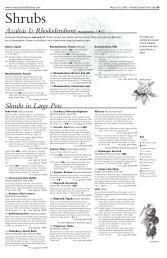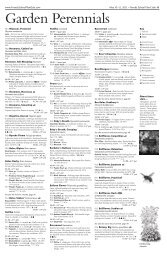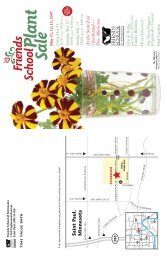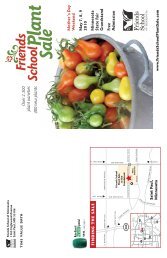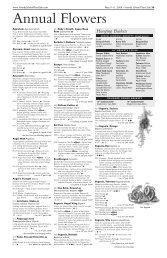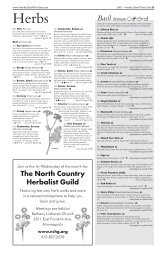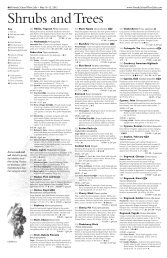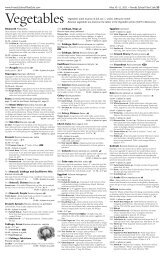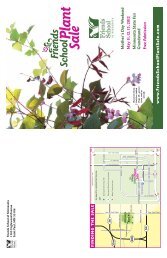View the 2013 56-page PDF here - Friends School Plant Sale
View the 2013 56-page PDF here - Friends School Plant Sale
View the 2013 56-page PDF here - Friends School Plant Sale
Create successful ePaper yourself
Turn your PDF publications into a flip-book with our unique Google optimized e-Paper software.
www.<strong>Friends</strong><strong>School</strong><strong>Plant</strong><strong>Sale</strong>.com May 10–12, <strong>2013</strong> • <strong>Friends</strong> <strong>School</strong> <strong>Plant</strong> <strong>Sale</strong> 27<br />
Climbing <strong>Plant</strong>s<br />
Annual Vines<br />
C001 Bell Vine, Purple ß<br />
Rhodochiton astrosanguineum<br />
Beautiful and vigorous in a sunny location. Heartshaped<br />
green leaves with long, tubular, dark purple<br />
flowers with parasol-shaped rose calyces. Climbs by<br />
twining. 10’h Í∏ †<br />
$2.00—3.5” pot<br />
Black-Eyed Susan Vine<br />
Thunbergia alata<br />
Winsome trailing or twining vine with masses of<br />
1” tubular flowers with flat, open faces and dark eyes.<br />
긠<br />
$2.00—3.5” pot:<br />
C002 Susie ß—Large 1.5” orange blooms. 4–5’h<br />
$7.00—4.5” pot:<br />
C003 African Sunset ß—Distinctive warm terra cotta<br />
shades. Vigorous. 10’h<br />
C004 Arizona Dark Red ß—Deep persimmon-red.<br />
6–8’h<br />
C005 Sunny Lemon Star ß—Lemony yellow. 10’h<br />
C006 Sunny Susy Red Orange ◊ß—Deep redorange.<br />
6–8’h<br />
C007 Bleeding Heart Vine ß<br />
Clerodendrum thomsoniae<br />
This West African vine will repeatedly reward you with<br />
massive clusters of white and scarlet flowers. 10–12’h<br />
Í∏ †˙<br />
$14.00—5.25” pot<br />
C008 Canary Bird Vine ß<br />
Tropaeolum peregrinum<br />
Bright yellow flowers and deeply lobed foliage. The<br />
flowers are said to look like canaries, but some see<br />
<strong>the</strong>m as troll dolls with wild yellow hair. Blooms all<br />
summer into fall. Climbs by long leaf stalks. 12’h Í∏<br />
´ $3.00—3.5” pot<br />
C009 Candy Corn Flag Manettia luteorubra<br />
Blooms resemble candy corn, orange with yellow tips.<br />
A fun novelty for small trellises, basket or pots. More<br />
vigorous in part shade. Twines. 3–4’h Í∏ †<br />
$2.50—2.5” pot<br />
C010 Chinese Red Noodle Bean<br />
Vigna unguiculata<br />
Fantastic deep red 18” pods are delicious, full of nutrition,<br />
and keep <strong>the</strong>ir color when sautéed. This incredible<br />
variety will draw lots of attention. Fast cover for a<br />
chain link fence. Twines. 30’h Í †Ç<br />
$7.00—4.5” pot<br />
C011 Cup and Saucer Vine<br />
Cobaea scandens<br />
Striking 2” flowers that change from green to lovely<br />
violet. If planted in a sheltered spot, <strong>the</strong> flowers continue<br />
after early frosts. Graceful climber, suitable for<br />
tub culture. Climbs by tendrils. 25’h Í∏<br />
$6.00—3.5” pot<br />
C012 Firecracker Vine Mina lobata<br />
In full sun, one plant can easily produce several hundred<br />
arching sprays of aligned flowers in a spectacular<br />
color combination, August through frost. Each 1”<br />
flower begins rich red and matures to orange, <strong>the</strong>n to<br />
yellow and finally to white. All colors are out at once.<br />
Self twining; more restrained in part shade. 20’h Í∏<br />
$2.00—3.5” pot<br />
C013 Hyacinth Bean Dolichos lablab ß<br />
Ruby Moon—Rose-purple fragrant wisteria-like flowers<br />
in loose clusters midsummer through fall. Elegant<br />
purple-tinged heart-shaped leaves. Showy, glossy deep<br />
magenta-purple seed pods in fall are a bonus.<br />
Vigorous, fast-growing twining climber that needs a<br />
strong trellis. Grown as food in tropical areas, <strong>the</strong><br />
young shoots, immature pods, and flowers are edible,<br />
but dried pods and seeds can cause stomach upset<br />
without special treatment in cooking. 10–20’h Í<br />
Ç´˙¥<br />
$7.00—4.5” pot<br />
C014 Love-in-a-Puff ß<br />
Cardiospermum halicacabum<br />
Small white flowers followed by light green inflated<br />
pods containing seeds marked with a distinct little<br />
heart. Quick-growing vines with pretty, lacy foliage are<br />
excellent for covering wire fences. Climbs by tendrils.<br />
10’h Í∏ $7.00—4.5” pot<br />
C015 Moonflower, Climbing ß<br />
Ipomoea noctiflora alba<br />
Giant 5-6” white trumpets unfurl as evening approaches<br />
releasing a lovely fragance. The blooms gently spiral<br />
closed with <strong>the</strong> rising sun. Vigorous twining climber.<br />
10–30’h ÍΩ¥<br />
$7.00—4.5” pot<br />
Passion Flower Passiflora<br />
Outlandish flowers late summer through fall with<br />
lush, dark green foliage. Can be grown in a tub and<br />
allowed to spend winter dormant in a frost-free basement.<br />
Prefers well-drained soil and plenty of sun. Late<br />
to break dormancy in spring. Climbs by tendrils. ͆<br />
$9.00—3.5” pot:<br />
C016 Blue, P. caerulea—Blue and white flowers late<br />
summer through fall. 15’h<br />
C017 Red, P. coccinea—Spectacular red flowers. 15’h<br />
$10.00—4” pot:<br />
C018 Giant Granadilla, P. quadrangularis ◊ß—<br />
Fragrant 5” deep red flowers with a frilly, fancy<br />
white and purple banded center. A too-small pot<br />
encourages flowering. Sunny south window as a<br />
houseplant. Fast-growing. It would be a challenge<br />
to get its nine-pound passion fruit in Minnesota.<br />
30–50’h<br />
C019 Rex Begonia Vine Cissus discolor ß<br />
Velvety elongated heart-shaped leaves are patterned<br />
with silver-frost and rich green with a central burgundy<br />
stripe. The undersides of <strong>the</strong> leaves, <strong>the</strong> stem,<br />
and <strong>the</strong> clinging tendrils are all burgundy-red, while<br />
<strong>the</strong> youngest foliage is sprinkled with crimson. Best in<br />
light shade with consistently moist soil. Stays 12–36”<br />
in containers and can be trained to a form. Can be<br />
over-wintered indoors. 10–12’h ∏Ó †ç<br />
$14.00—5.25” pot<br />
C020 Sky Vine Thunbergia grandiflora<br />
Blue Sky—Clusters of light blue-purple trumpet flowers<br />
2–3” wide and 4–6” long. Twining shrub form, also<br />
good as a trailing plant. 15–20’h Í †<br />
$3.00—2.5” pot<br />
C021 Snapdragon, Climbing<br />
Asarina antirrhiniflora<br />
Red—Blooms early summer until frost. Twining.<br />
Masses of 1” trumpet shaped brilliant red blooms with<br />
yellow throats. Perfect for trellises or hanging pots.<br />
3–6’h Í∏<br />
$7.00—4.5” pot<br />
See also <strong>the</strong> BITTER MELON, <strong>page</strong> 23, and MALABAR SPINACH, <strong>page</strong> 24<br />
Minnesota State Horticultural Society Members<br />
SAVE $5 on your purchase of $50 or more at <strong>the</strong><br />
<strong>Friends</strong> <strong>School</strong> <strong>Plant</strong> <strong>Sale</strong>!<br />
Be sure to have your MSHS membership card with you.<br />
Not a member? Join MSHS at our membership table during <strong>the</strong> sale<br />
and save $5 off <strong>the</strong> membership AND receive a special<br />
gift for joining. Plus $5 off your plant sale purchase.<br />
Please Note: MSHS table will be staffed during <strong>the</strong>se times—<br />
<br />
Package includes:<br />
Nor<strong>the</strong>rn Gardener magazine<br />
Reuseable tote bag<br />
Minnesota Hardy booklet<br />
Seed Savers Exchange catalog<br />
Osmocote Plus Fertilizer<br />
Perennial Vines<br />
C022 Asparagus, Vining Asparagus verticillatus<br />
Glossy rich green foliage with many small white flowers in <strong>the</strong> leaf axils. Spring<br />
blooms. Twining. 15’h Í∏ ¥<br />
$3.00—2.5” pot<br />
C023 Bittersweet Celastrus scandens<br />
Autumn Revolution—Bright red to orange berries are wonderful in dried arrangements.<br />
Vigorous and twining variety of <strong>the</strong> American native climber. This introduction<br />
from Bailey Nurseries is a revolution in bittersweet. Not only self-fruiting, it<br />
produces berries twice <strong>the</strong> normal size, every year. 15–25’h Í ˜¥<br />
$14.00—1 gal. pot<br />
C024 Bleeding Heart Vine, Yellow Dicentra scandens ß<br />
From <strong>the</strong> Himalayas, this unusual and delicate-looking climber has fern-like foliage<br />
and cascades of bright yellow flowers in summer. Climbs by twining. 10–12’h Í∏<br />
¥ $2.00—2.5” pot<br />
C025 Bleeding Heart, Climbing Adlumia fungosa<br />
Biennial vine for shade. Pearly pink spurred blossoms. Native to Appalachia and <strong>the</strong><br />
north shore of Lake Superior in Minnesota. Climbs by leaf tendrils. 6–10’h Í∏Ó<br />
˜<br />
$3.00—2.5” pot<br />
Chocolate Vine Akebia<br />
Perfect for growing on fences, pergolas or by <strong>the</strong> patio w<strong>here</strong> <strong>the</strong> scent will pervade.<br />
Twining. Í∏<br />
$3.00—1 quart pot:<br />
C026 Five-Leaf, A. quinata—An eye-catching climber with clusters of rounded leaves<br />
and racemes of captivating chocolate-purple blooms with a spicy fragrance.<br />
30’h<br />
C027 Three-Leaf, A. trifoliata—Elegant twining vine from China with large attractive<br />
three-part leaves and faintly scented dark-purple flowers in mid-spring.<br />
Combines nicely with a clematis. 4–6’h<br />
Clematis see <strong>page</strong> 30<br />
C053 Dutchman’s Pipe Aristolochia durior<br />
Large, heart-shaped dark green leaves, great screening. Excellent larval food for butterflies.<br />
Small, yellow-brown flowers look like a clay pipe. Tolerant of shade and dry<br />
soil; spreads from <strong>the</strong> roots. Over time will provide a complete screen of green.<br />
Climbs by tendrils. Syn. A. macrophylla. 20–30’h Í∏Ó ∫ΩÂ¥<br />
$14.00—1 gal. pot<br />
Grapes see <strong>page</strong> 41<br />
C054 Honeysuckle, Kintzley’s Ghost Lonicera reticulata ◊<br />
O<strong>the</strong>rworldly silver-white discs that resemble eucalyptus leaves encircle yellow<br />
flower clusters in June, <strong>the</strong>n persist into fall as little orange-red berries appear.<br />
Found in a college greenhouse in Iowa in <strong>the</strong> 1880s by horticulturist William<br />
Kintzley and shared with family members, this unusual heirloom vine was rediscovered<br />
in <strong>the</strong> Colorado yard of a grandson in 2001. Twining, aphid-resistant, and compact<br />
for a honeysuckle. 8–12’h after ten years. 4–6’h by 2–5’w Í ˙∫Ω¥<br />
$12.00—1 gal. pot<br />
Honeysuckle, Scarlet Lonicera x brownii<br />
Blooms, more coral-scarlet than scarlet, are excellent for attracting hummingbirds<br />
and orioles. Good for fences or trellises. Twining. Bred in Manitoba. 12’h Í˙Ω¥<br />
$3.00—3.5” pot:<br />
C055 Dropmore Scarlet ß<br />
$12.00—1 gal. pot:<br />
C0<strong>56</strong> Dropmore Scarlet, larger pot<br />
Honeysuckle, Trumpet Lonicera sempervirens<br />
A vigorous grower popular with hummingbirds, nectar-seeking moths and o<strong>the</strong>r<br />
insects. Orange-red berries, which many birds relish, appear after <strong>the</strong> flowers.<br />
Beautiful blue-green foliage. It needs at least a half-day of sun for good blooms.<br />
Climbs by twining. Í∏˙Ω¥<br />
$8.00—1 quart pot:<br />
C057 Blanche Sandman—Deep rose flowers blooming sporadically from May until<br />
frost. 12’h<br />
C058 John Clayton—Discovered by a member of <strong>the</strong> Virginia Native <strong>Plant</strong> Society,<br />
this honeysuckle has lovely, soft-yellow, tubular flowers that are slightly fragrant.<br />
10–20’h<br />
$14.00—5.25” pot:<br />
C059 Major Wheeler ß—Masses of bright red trumpets that start blooming in late<br />
spring. 3–8’h<br />
C060 Honeysuckle, Variegated Lonicera periclymenum ß<br />
Harlequin—Foliage is green edged in cream, frequently with pink highlights. Yellow<br />
and pink fragrant flowers from June to October. Compact and slower growing.<br />
Moist, well-drained soil. Twining. 10–12’h Í∏ ç˙Ω¥ $3.00—3.5” pot<br />
Hops Humulus lupulus<br />
This fast-growing vine has maple-like leaves. Pine-scented greenish flowers resembling<br />
cones are attractive to butterflies. The young shoots are edible like asparagus.<br />
Dried, <strong>the</strong> flowers are also a key ingredient in beer. Dies back to <strong>the</strong> ground each<br />
winter. Strong spreader from <strong>the</strong> roots. Twining. Í∏∫Â<br />
$2.00—2.5” pot:<br />
C061 Golden, Aureus ß—Bright chartreuse leaves. 15–25’h<br />
$13.00—1 gal. pot:<br />
C062 Golden, Aureus—Larger pot. Bright chartreuse leaves. 15–25’h<br />
C063 Willamette ◊—More fruity and floral than Fuggle. They tell us beer brewers<br />
will know what that means. 20’h<br />
Hardy Kiwi see <strong>page</strong> 41<br />
www.nor<strong>the</strong>rngardener.org


